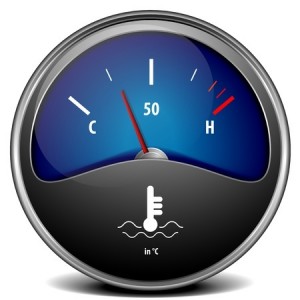 Oil may be the lifeblood of an engine, but without coolant you might as well start taking the train to work. As its name implies, coolant is an integral part of the temperature regulation system in your vehicle. Coolant, in conjunction with your vehicle’s radiator, keeps your engine running at a sweet spot of around 200°F. At this temperature, an engine is hot enough to keep oil viscosity low and effectively vaporize fuel, but not hot enough to warp or break internal components.
Oil may be the lifeblood of an engine, but without coolant you might as well start taking the train to work. As its name implies, coolant is an integral part of the temperature regulation system in your vehicle. Coolant, in conjunction with your vehicle’s radiator, keeps your engine running at a sweet spot of around 200°F. At this temperature, an engine is hot enough to keep oil viscosity low and effectively vaporize fuel, but not hot enough to warp or break internal components.
Overheating an engine can do serious, sometimes irreversible damage, so it’s a good idea to pay special attention to your cooling system. Most automobile manufacturers recommend that you drain your system completely and add new coolant once every two to three years. Why? Over time, the chemical components of coolant will break down due to the extreme heat of the environment in which they operate. Among these chemical components is a rust inhibitor which keeps coolant passageways in your engine block from corroding. Over time, the rust inhibitor will degrade and cease to be effective, thereby subjecting your engine to undue wear. If you live in a place where the weather gets hot, like Lancaster, California, this will happen more quickly, so you may want to consider changing your coolant as often as once a year.
If you decide to try replacing your car’s coolant on your own, you’ll first want to locate your radiator’s drain plug. Open the cap at the top of the radiator in order to relieve pressure. Next, position a catch pan beneath the radiator and unscrew the plug to release the coolant. Remember, never add or replace coolant when an engine is hot. You can do serious harm to both yourself and the engine.
Once you’ve drained your old coolant, you’ll want to find an appropriately sized receptacle to keep it in until you are able to dispose of it properly. Used milk jugs tend to work nicely. Antifreeze has a sweet taste and is extremely toxic, so you should be especially mindful of this step if you have pets.
Next, you’ll want to flush your engine block of any remaining coolant. Leave your radiator cap and drain plug open, and again make sure that you have a catch pan in place. Start your engine and pour water into the top of the radiator. When the water runs clear out of the drain, you’ll have removed any excess coolant from the engine block. Once you’ve completed this step, turn off the engine immediately.
Next, tighten the drain plug and prepare to add new coolant. Some antifreeze will require you to mix it with a 1:1 ratio of water. Most modern antifreeze, however, comes premixed. If you see “50/50” on the bottle, then you won’t need to worry about mixing.
Pour coolant into the radiator until the coolant reservoir is filled to the “full” mark. Start your engine briefly to circulate the coolant, and then fill the reservoir again as needed. You’re likely to have some air pockets in your cooling system at this point, so you may have to repeat this step a few times in order to achieve adequate coolant levels.
Once you’ve completed this step, make sure the caps on both the reservoir and radiator are securely tightened. Keep an eye on your coolant levels in case more air pockets break. If you need to add more coolant in the future, you can simply add it to the reservoir rather than the radiator itself.
Changing your coolant regularly will increase the longevity of your engine and provide you with an added degree of peace of mind. We provide affordable, expert coolant flushes here at our auto repair shop in Lancaster, California. If you have any questions or concerns about your cooling system, don’t hesitate to contact us. At AV Bumper to Bumper, we’re always happy to help.




